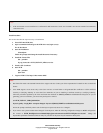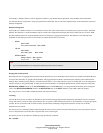
Cisco Internal Use Only
Copyright © 2006 Cisco Systems, Inc. All rights reserved.
Page 56 of 66
restart. If Cisco PVM is manually stopped, it will have to be restarted manually as well.
2. When Cisco PVM is started manually, ensure that you are starting it as ‘pvmadm’ user. Also, Cisco PVM starts both the Oracle
processes and the Cisco PVM server processes when the pvm start command is issued. To do this it uses the ‘sudo’ process available in
Linux to start Oracle as the ‘oracle’ user. If your network security process prevents access to the ‘pvmadm’ user to perform this
operation, Cisco PVM will start the server processes and you will be unable to login to PVM or see any data. If this is the case, you will
have to manually start the Oracle processes.
Login as root and perform the following procedure:
$su - oracle
$export ORACLE_SID=cnam
$sqlplus /nolog
sqlplus>connect /as sysdba
sqlplus>startup
sqlplus>quit
$export ORACLE_SID=spdw
$sqlplus /nolog
sqlplus>connect /as sysdba
sqlplus>startup
sqlplus>quit
$lsnrctl start
3. A similar situation is encountered while stopping Cisco PVM if ‘sudo’ access is not granted to the ‘pvmadm’ user. In this case you
have to manually stop the Oracle processes.
Login as root and perform the following procedure:
$su - oracle
$export ORACLE_SID=cnam
$sqlplus /nolog
sqlplus>connect /as sysdba
sqlplus>shutdown immediate
sqlplus>quit
$export ORACLE_SID=spdw
$sqlplus /nolog
sqlplus>connect /as sysdba
sqlplus>shutdown immediate
sqlplus>quit
$lsnrctl stop
Troubleshooting Tips:
1. The status of the start and stop commands is shown in the shell environment from which you issue those commands. If you find any
error messages during startup or shutdown, re-issue those commands. If the problem is encountered again, you can try starting it
manually.
Maintaining and Troubleshooting Cisco PVM


















